The word parakeet comes from the Middle French word perroquet, meaning “long tail.” Parakeets are those hookbill birds that have long tails. There are almost 130 species and subspecies of parakeets. They are usually considered small birds, but different types of parakeets range from small to medium size.
Parakeets are social and playful; they love to interact with other animals and humans. They require an accommodating environment where they can play and engage themselves in different activities. If it suits them, they quickly get adapted to the new environment, cage, and owners.
Parakeets are classified as birds belonging to the parrot family. But not all of them are preferred as pet birds. But of all the breeds of parakeets, only 40 are considered pet birds. Which one might suit you? Below, we list down 8 most common types of parakeets to find your partner in.
Types of Parakeets
Parakeets, formally known as budgie, have different types, including small parakeets like budgerigars (colorful bird) and even large parakeets like the Alexandrine parakeet (which change color as it mature). They are categorized based on their region into two groups, Asiatic and grass parakeets.
- Asiatic Parakeet
| Birds Type | Origin |
| Moustache Parakeet Indian Ring Neck Parakeet Plum-Headed Parakeet | India Indonesia Sri Lanka |
- Grass Parakeets
| Birds Type | Origin |
| Splendid Parakeets Rosellas Bourke’s Parakeets | Australia |
8 most common types of parakeets that are kept as pets are:
- Alexandrine Parakeet
- Monk Parakeet
- Plain Parakeet
- Moustache Parakeet
- Budgerigar
- Indian Ring Neck Parakeets
- Plum-Headed Parakeet
- Blossom-Headed Parakeet
1. Alexandrine Parakeets

Alexandrine is named after Alexander the Great because he brought Alexandrine parrots to the Mediterranean and Europe, where they were very famous in the upper-class and nobility. They are medium size parakeets, considered very bright, independent, and gentle birds. Alexandrine is relatively quieter than other birds. They belong to the Asiatic Parakeet category as they are native to India and Sri Lanka.
Their height range from 30-35 cm, and the color range lies in the green color spectrum. If provided proper care and a suitable environment, Alexandrine can live up to 30 years. Always found in flocks, they are very social, but sometimes they get territorial or frisky in the presence of other birds.
Alexandrine parakeets are more expensive than other parakeets because of their big size and their lack of availability. They love chewing on things. To keep them occupied, provide them with enough chewing perches, seeds, or wood.
They do not require much maintenance as they can eat various things like seeds, fruits, leaf buds, and nuts. The only maintenance required is cleaning their cage regularly as they love a clean environment.
2. Monk Parakeet
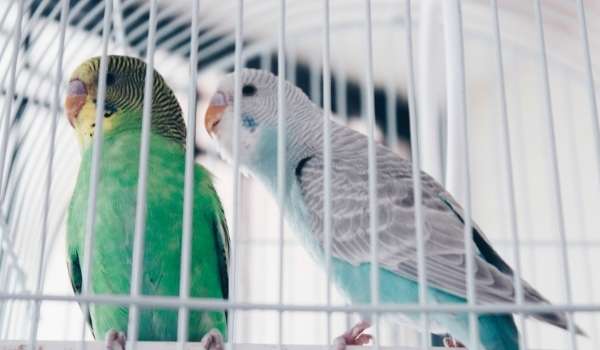
Monk parakeets are native to South America. Since they prefer to live in flocks, they are called Monk parakeets. They thoroughly enjoyed their share of popularity for pet trading back in the 1960s. Thanks to their intelligence, they can be tamed easily.
Categorized as a medium-size parakeet, Monks’ size can grow up to 29cm. Their life-span is 6-7 years in the wild, but if kept with proper care, they can live up to 15 years. Their color spectrum ranges from green and blue with grey breast and face and pale pink bill.
Monk parakeets are boisterous birds, chirping and talking to each other all the time. They feed on seeds, nuts, fruits, green grasses, and leaves. Did we mention that they readily get attached to their owners and try to mimic their words? Monk parakeets are the only birds in the parrot family that builds nest colonies and stick nests. There are 20 nest chambers in a single nest structure, and in some cases, even a single nest structure can contain more than 200 nests.
3. Plain Parakeet
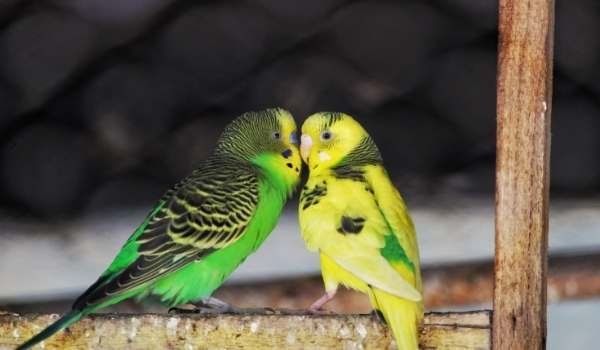
Plain parakeets, scientifically known as Brorogeris tirica, are ubiquitous birds found on the coast of Brazil, up to the Atlantic Rain Forest. Their natural habitats are lowland evergreen forest areas, trees, bushes, woodland, and urban areas. Plain parakeets do not live alone. You will often find them in pairs, groups, or flocks. They are categorized as medium parakeets as they can grow only up to 25 cm.
Plain parakeets’ color spectrum ranges from blue to green. Usually, their plumage is green, and their bill brown. There is no significant difference between male and female Plain parakeets—in appearance, they are similar to each other. Plain parakeets live up to 15 years if handled with care in a suitable environment.
These noisy birds feed on seeds, flowers, grits, algae, insects, and fruits. However, when kept as pets, a high-quality dry parrot mix is very suitable for them. Unlike other parakeets, they are not that intelligent birds. However, they can learn to mimic their owners if given enough time and attention.
4. Moustache Parakeet
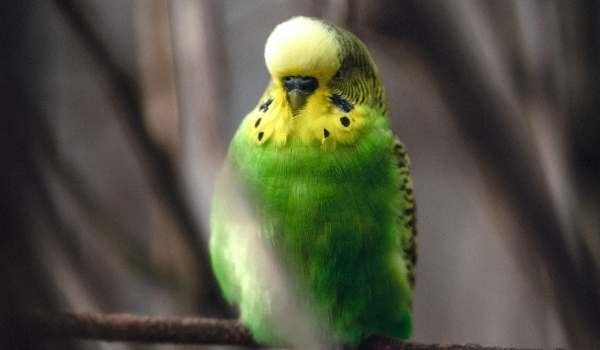
They are named Moustache parakeets because of their featured feather above their beak, resembling a well-grown mustache. Moustache parakeets are commonly known as Java parakeets. They are native of southeast Asia, therefore, categorized as Asiatic parakeet. In the wild, they live in flocks, with each flock of up to 50 birds. Although they do not build colonies like other parakeets, their pairs leave the flock during mating season and live in tree cavities until their chicks grow up.
Moustache parakeets can grow up to 38 cm. Therefore, they are also categorized as large parakeets. Like Alexandrine parakeet, they can also live up to 25 years—of course, if kept with care. These beautiful small birds are available in a full spectrum of colors in their feathers. They have powder blue heads with greenish-blue feathers and tails. One can easily distinguish between male and female parakeets—males have mandible with a yellow tip and female has dark gray or black beak.
They are not very noisy birds like other parakeets. They are relatively quieter in terms of squawking and screaming when alone, but they can become very noisy in flocks. Moustache parakeets are a very intelligent parakeet breed. Unfortunately, this beautiful bird is an endangered breed due to the loss of its natural habitat.
5. Budgerigar

Budgerigars are often simply known as parakeets. Since they are native to Australia, they are categorized as Grass Parakeets. In the wild, budgerigars are found in the flocks of 10-90 birds and usually breed in the rainy season due to the copious supply of food and water. Budgerigars do not build nests, usually living in tree limbs or hollowed trees.
The Latin name budgerigar means “songbird with wavy lines,” providing a decent portrayal of this bird. Because of their small size, they are very popular among bird lovers. Budgerigars are available in four colors: blue, green, white, and yellow. However, there are many breeds of budgerigar with their unique feather arrangement and diverse colors. The only way to differentiate sex among budgerigar is their cere, as males have royal blue cere and female brown. However, baby budgerigar of both sex has pink cere.
Budgerigars are easygoing, friendly birds and adapt easily to changing environments, humans, and birds. But they would never share their space with another bird other than a budgerigar. Even in some cases, two budgerigars cannot easily get along; you must be careful while putting two budgerigars together. They are low-maintenance birds, feeding only on seeds and fruits. Their lifespan is up to 10 years—you have enough time to train them and build an unbreakable bond with them.
They can learn to mimic the words and tones. They even try to copy other pet’s words like “meow.” However, many budgerigars prefer non-verbal communications like shrieking and stomping when they want food.
6. Indian Ring Neck Parakeets
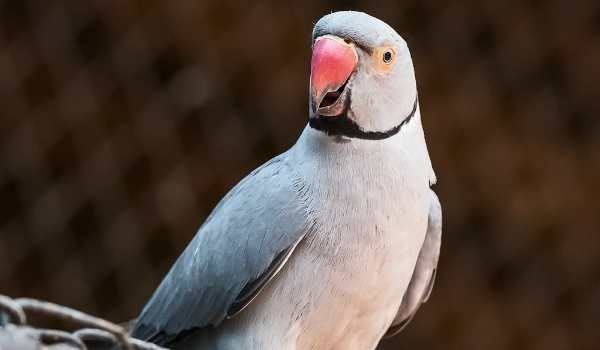
Indian Ring Neck parakeet is also known as “rose-winged parakeet.” As their name indicates, they are natives of India and are still found in great quantity in the wild. Belonging to the Asiatic Parakeet category, they are considered very popular bird pets. However, it may not be a suitable pet for everyone as it requires a lot of care and attention. In the wild, these birds are always found in flocks with more than 100 birds in each flock.
Indian Ring Neck parakeets belong to the medium bird category, with a maximum size of up to 40 cm. However, unlike other birds, their life expectancy is up exceptionally high—up to 50 years. They are found in diverse colors, from green and blue to bright yellow, cinnamon, albinos, and lutinoes. They are dimorphic species as their color or marks can help one to determine their sex. Male Indian Ring Necks got deep red beaks with black facial markings, having three color bands around their necks. The first black band starts developing after 18 months, and after three years, blue and pink rings appear. Whereas females do not have facial marks and collar rings, though some females have darker skin around their necks.
Ring Nicks are noisy and smart birds and can prove to be a great companion for the entire family. They love to talk, some of them can speak up to 200 words. They adapt to the new environment pretty easily and enjoy learning new things that make training them an activity full of fun and amusement.
7. Plum-Headed Parakeet
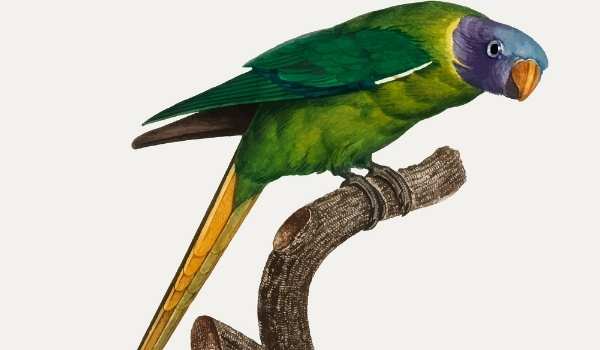
Plum-headed parakeets, mostly known as plum-headed parrots, are native to Pakistan, India, Sri Lanka, and Bangladesh. These birds are the inhabitant of forest areas and woodland where they live on trees. Although their numbers are dwindling because of habitat loss, plum-headed parakeets are not yet considered an endangered breed. They are mostly found in the form of pairs or flock of 10 birds.
With a size of up to 30cm, they are from the medium birds’ category. Their color spectrum range includes a green body with different head colors. Like Indian Ring Neck parakeets, Plum-Headed parakeets are also dimorphic species—both their sexes can be easily identified. Males have a purple-red head with a black ring on their neck, whereas female lack ring and has gray-blue feathers on their heads. Plum-headed parakeets can live up to 20 years, although some can even live up to 30 years.
Because of less possessive and aggressive nature, Plum-headed parakeets are considered an excellent bird pet. They can share their space and get along quickly with other birds and humans. Unlike Indian Ring Necks, they do not require a lot of attention and time from their owners. They are also active birds like other parakeet species and can be trained to talk and ape their owners’ speech.
8. Blossom-Headed Parakeet
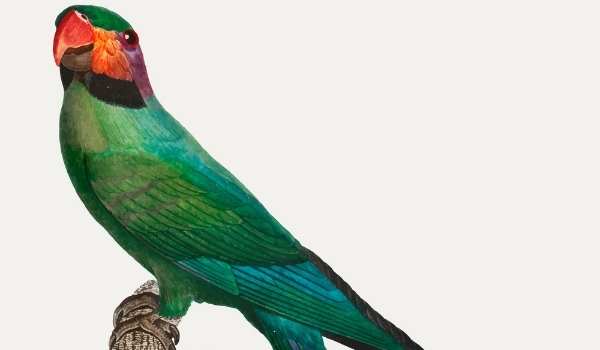
Blossom-Headed parakeets are the most common types of parakeets found in India and Southeast Asia. They are known as birds of forest and woodland, living in the hole of trees. Blossom-headed parakeets are primarily found in pairs and flocks of 10 birds. The important fact about blossom-headed parrots is that they have been pet parrots for centuries.
It is a medium size bird that grows up to 30cm. Like Plum-Headed parakeet, these parakeets’ color spectrum lies in green with different head colors for male and female (dimorphic species). Male Blossom-Headed parakeets are entirely green with a light lime green body and dark green wings. They have a pale red-pink head, which turns to blue on the crown, giving a lovely hue similar to the cherry blossom. For the same reason, they are named as Blossom-Headed parakeets. Male also have a ring around their neck. In contract, female Blossom-Headed parakeets lack ring around their neck and their head is pale blue-grey.
Blossom-headed parakeets are closely related to Alexandrine parakeets. Perhaps they are the most popular pet parrot breeds of all. Like Alexandrine parakeets, they also can live up to 20 years. Unlike Alexandrine parakeets, they are not very intelligent but still can be trained to repeat a few words.
